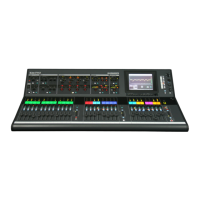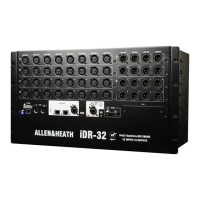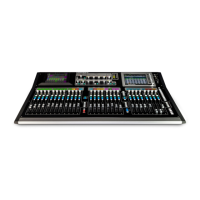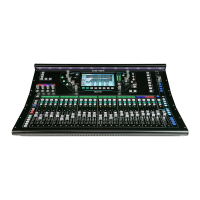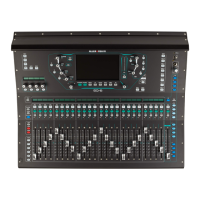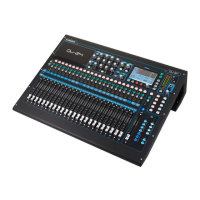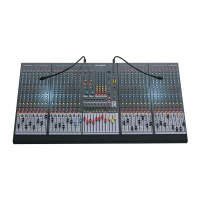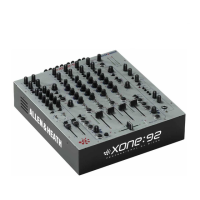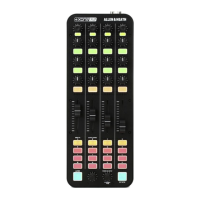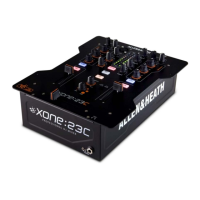
Do you have a question about the ALLEN & HEATH iLive-T112 and is the answer not in the manual?
| Type | Digital Mixer |
|---|---|
| Touchscreen | Yes |
| EQ Bands | 4-band parametric EQ per channel |
| Talkback | Yes |
| Fader Channels | 28 |
| MIDI Ports | In/Out |
| Channels | 64 |
| Effects | 8 internal FX processors |
| Computer Connectivity | Ethernet |
| I/O Expansion Slots | 2 |
| Fader Configuration | 28 Faders |
| Dynamic Processing | Gate, Compressor, Limiter |
| A/D Conversion | 24-bit |
| Power Supply | Internal |
Read the Important Safety Instructions printed on the sheet supplied with the equipment.
Describes the iLive system operating firmware and how to use its feature set.
Refer to User Guides, HELP MANUAL, and the Allen & Heath web site for more details.
The operating code that tells the iLive hardware and its controls how to function.
Diagram showing MixRack, Surface, TouchScreen, and external connections.
Key interface components: TouchScreen, assignable Soft Keys, and fader control strips.
Details system CPUs, processing blocks, and audio network interface modules.
Ports and functions for data transfer, external display, power, monitoring, and scene recall.
Control section with rotary controls, switches, and meters for channel/mix processing.
Details fader banks, soft keys, touchscreen, and talkback functionality.
Ports for external monitor, data transfer, PAFL, networking, and MIDI control.
Displays system status including firmware, temperature, and network connection health.
Displays real-time clock, current logged-in user, and last recalled Show.
Provides current mix, scene, monitoring status, USB connection, and error indicators.
Displays screen/channel name and allows navigation between pages.
Shows system status and provides controls for parameter adjustment.
Keys to change screen function and the main display area.
Different TouchScreen views for system status, channel processing, meters, and routing.
Access FX rack, Scene memories, and channel naming/colouring.
Configure MixRack, Surface assignments, and system utility functions.
Displays signal levels, DCA/SAFE status, and send modes.
Shows channel info, name, type, rotary settings, and fader status.
Controls for parameter adjustment and accessing channel processing.
Functions for monitoring (PAFL) and muting channels, mixes, or DCAs.
Describes fader function, layer management, and layer selection.
Functions for peak indication, freezing strips, alt view, and GEQ fader flip.
Physical controls for channel/mix processing, including meters.
Switching processing sections on/off and opening processing screens.
Access input channel parameters via analogue controls and TouchScreen views.
View assignments and send levels for selected channels on TouchScreen.
Access mix master parameters via analogue controls and TouchScreen views.
View assignments and send levels for selected mix masters on TouchScreen.
Access FX return PEQ settings and processing parameters.
View FX mix assignments and send levels on TouchScreen.
Open DCA assignment view and configure DCA groups as mute groups.
Explains how to view and adjust mixes via master, channel, or ROUTING view.
Guides on selecting, assigning, and setting pre/post fade for sends to a master mix.
Guides on viewing and adjusting sends from a specific input channel.
Controls for channel preamp gain, HPF, and selecting input sources.
Assign 5-character names and colours to channels and masters.
Detailed controls for preamp gain, trim, polarity, and digital inputs.
Gain sharing options and protecting preamps from Scene recalls.
Patching sources as mix master external inputs and selecting sources.
Setting names and colours for mix masters.
Noise gate with side chain filter and dynamics control.
Assign physical sockets as insert send/return for outboard processing.
4-band fully parametric equaliser with frequency and width controls.
HPF control and graphical EQ curve for parameter adjustment.
Selecting filter types for LF and HF bands (shelving, bell).
Third octave graphic equaliser for each mix output.
Controls for threshold, ratio, make-up gain, attack, release, and soft knee.
Processor for limiting signal or de-essing vocals.
Access delay settings for inputs and mixes for adjustment.
Virtual rack with 8 slots for loading effects processors.
Methods to patch FX into channels or as system effects.
Options to configure FX routing: Not Assigned, Insert, Mix>Return, Patch from/to.
Access FX parameters and send mixes from strips or TouchScreen.
Displays send/return master settings, PEQ, and dynamic FX shaping.
Manage FX presets: open library, recall, store new, and exit.
Detailed controls for MOO Phaser effect parameters.
Hypabass modes and controls for sub-harmonic synthesis.
Features and settings for Gated Verb effect, including nonlinear modes and filters.
Assign outputs available at the MixRack to physical or network sockets.
Assign Surface and network outputs to sockets via Port A and Port B.
List of sources that can be assigned to outputs: Group, Aux, Main, Matrix, Direct Output, etc.
Assign channels to DCA groups and use fader/keys for control.
Configure DCA groups as Mute groups by setting fader to unity '0' position.
Procedure to enter Ganging Setup mode and link parameters for channels.
Protected keys requiring hold-down and SEL/MIX press for copying, pasting, and resetting.
Hold COPY and press SEL/MIX to copy parameters to a clipboard.
Hold PASTE and press SEL/MIX to paste clipboard contents.
Hold RESET and press SEL/MIX to reset parameters to factory default.
View standard or user-defined meter pages and customize display.
Real-Time Analyser displays frequency analysis of monitored signals.
PAFL keys check signal associated with strip; SEL keys listen to signal at processing block.
PAFL keys, Solo-in-Place, and PAFL master controls; input PAFL overrides mix PAFL.
Select PFL/AFL modes, view PAFL levels, and check active indicators.
Controls for clearing PAFL, headphone/monitor levels, and connection details.
Listen to single channels by muting all others; SIP is destructive.
Rear panel inputs for external PAFL signals and MixRack headphone/socket details.
Configure PAFL settings: talkback source, additive mode, IEM headphone follow.
Modes that link PAFL key presses with MIX or SEL keys.
Adjust PFL trim balance and set main mix level for PAFL monitor.
Assign fader strips as mono/stereo Wedge and IEM masters for monitor mixing.
Patch monitor outputs to sockets and assign mixes to Wedge/IEM masters.
List of other monitor features like Auto input PAFL, Dual press PAFL CLEAR ALL.
Talkback microphone input, level control, output socket, and talk key operation.
Assign talkback destinations using MIX keys or the TouchScreen assignment page.
Configure TALK key operation and select the talkback system source.
Arrange communication between FOH and stage positions using talkback.
Assign functions to SoftKeys and configure DCA groups as mute groups.
Details on PL-6 and PL-10 remote controllers and their capabilities.
Displays current configuration and provides access to setup menus.
Views for input channels, mix buses, and FX buses within MixRack setup.
Configure audio bus, talkback, signal generator, PL devices, and channel ganging.
Configure mono/stereo for input channels and use Ganging for stereo sources.
Configure mix bus architecture, types, and output configurations.
Allocate output processing (EQ, dynamics) to engineer's monitor outputs.
Details mono to 4way main mixes and available configuration types.
Manage configuration: accept changes, assign strips, and store as Show memory.
Set global direct output sources, preamp options, and PEQ frequency ranges.
Choose the system digital clock sync source.
Configure input sources for channels and ranges.
Configure signal type, level, mute, and routing for the generator.
Assign channels/masters to Surface strips and layers.
Select channel types and reset strip assignments.
Assign a single strip by selecting channel type and number.
Assign a range of strips by selecting start and end channel numbers.
Lists available strip types and provides a reset function.
Assign functions to SoftKeys via SURFACE/SoftKey Setup page.
Assign PL remote control devices via SURFACE/PL-Anet Setup or MIXRACK SETUP/PL-Anet.
Select ALT VIEW functions via SURFACE SETUP/Alt View/Rotary Setup.
Displays alternative info on strip LCDs and defines rotary functions.
Define functions for Main, Shift, and Alt View rotary controls.
Configure Surface behavior: fader banks, display, contrast, talk switch, scene keys, RTA, temperature.
Assign names and colours to channels via processing view or dedicated screen.
Facility to create and store up to 48 most used names for quick application.
Manage user profiles, permissions, passwords, and login procedures.
Manage libraries: select, store, recall, archive, and transfer presets.
Manage Scene memories: setup preferences, name, store, recall, edit, and update.
Copy, paste, delete, and reorder Scenes for efficient management.
Add, update, and remove parameters from Scene memories.
Protect channels/masters from being overwritten by Scene recalls.
Lists all settable parameters for Scene memories across the system.
Transfer Scenes and Shows between USB key and iLive system.
Factory default Template Shows and user-customised Shows for recall/transfer.
User Shows require same or newer firmware than creation version.
Details which system settings are stored within Show memories.
Archive configuration as Show, recall Template/User/USB Shows via Show Manager.
List of stored User Shows and important notes on Show recall.
Categories of Template Shows: FOH, MON, and MicSplit for different applications.
Load Template Shows and recall Scenes for system setup and patching.
Make configuration changes and save them as a User Show.
Details of the FOH-LRSub default Show: bus config, audio, strip layout, MixRack.
Manage USB data: directory structure, archiving, and key handling.
Transfer Scenes and Shows between USB key and iLive system.
Navigate UTILITY screen pages and access functions like locking, user change, help, and power down.
Access configuration, diagnostics, firmware update, and network settings.
Display current firmware versions for TouchScreen, Surface, and MixRack.
Steps to update system firmware using a USB key.
Detailed steps for downloading, extracting, copying, saving, and performing firmware update.
Steps to update firmware using Editor software via PC connection.
View and manage network connections and setup for system devices.
Set unit names and reset network settings to factory defaults.
Configure multicast for network performance and enable it via setup screen.
Connect laptop via CAT5 cable or wirelessly to control iLive with Editor.
Configure network settings and security for optimal Editor connection.
App features, network config, router settings, DHCP, security, SSID, and Wi-Fi optimization.
Download and install iLive Tweak app, then configure iPhone Wi-Fi.
Connect Tweak to iLive, select user, login, and select channels for adjustment.
Control channels with Tweak, use demo mode, and troubleshoot connection issues.
Steps for network settings, connecting system, and setting up Dual-Rack configuration.
Identify system errors via red cross on Status page or yellow triangle in toolbar.
Meaning of error indicators: Firmware, Surface Lock, MixRack Lock, and Temperature errors.
Troubleshoot connection failures: check cables, ACE, network addresses.
Troubleshoot Dual-Rack IP conflicts and reset network settings.
Troubleshoot lost connection, laptop, and iPhone connection problems.
Address firmware incompatibility and issues loading User Shows.
MIDI tunneling, and messages supported by firmware versions.
MIDI parameters for channel control, mute, and fader levels.
MIDI messages for assigning channels to Main Mix and DCA groups.
MIDI messages for controlling channel and socket preamp gain.
MIDI messages for controlling socket preamp pad and 48V phantom power.
MIDI messages for getting or setting channel name and colour.
MIDI messages for recalling Scenes via Bank and Program Change.
Technical details: format, DSP, latency, I/O, connections, architecture.
Surface controls, functions, remote control, and iLive Editor software details.
Details on memory types, user profiles, and physical dimensions/weights.
